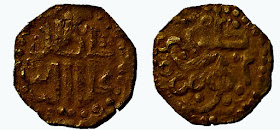This is a gold coin from Sultanah Taj Alam Safiat AdDin Shah era. She is the first female to be throned in Aceh Sultanate. She was a widow of Sultan Iskandar Thani. She reigned Aceh from 1641 - 1675 CE.
Looking at the Arabic calligraphy used, its quite tricky as the calligraphy is compressed to fit on the coin face. However it has the resemblance to Thuluth & Sini. Or probably this is how Malay calligraphy was derived.
Obverse : فادك سر يلطانه تاج العالم
Paduka Sri Sultanah Taj Al Alam
Reverse : صفية الدين بردولة شاه
Safiat Aldin Berdaulat Shah
Aceh is a state located at the northern end of Sumatra island ( Indonesia). It is also known by its Arabic honorific Darus Salam ( Abode of Peace) from 1511-1959 CE.
Aceh's origins are unquestionably Cham, as the Champa king Syah Pau Kubah sent his son Syah Pau Ling to rule over Aceh when the capital Vijaya in 1471 AD, was sacked by the Vietnamese Le Dynasty.
The Sultanate of Aceh was founded in 1511 CE after the fall of Pasai Sultanate by Sultan Ali Mughayat Shah. It’s presumed that he is the same person as Syah Pau Ling who converted to Islam.
The Sultanate lasted till 1903 when the last Aceh Sultan Muhammad III Daud Shah Johan Berdaulat surrendered to Dutch occupation.
Look my other variation of this coin in below link :
Taj Alam 9
Obv: فادك سر يلطانه تاج العالم Paduka Sri Sultanah Taj Alam
Rev: صفية الدين بردولة شاه Safiat Ad Din Berdaulat Shah
Weight : 0.61 gm
Dim : 1641 - 1675 CE
Rarity :
Denom : Mas
Material : Gold
Reference : A 17a type 1 pg 177 ( Jaarboek Voor Munt-en Penningkunde)





















